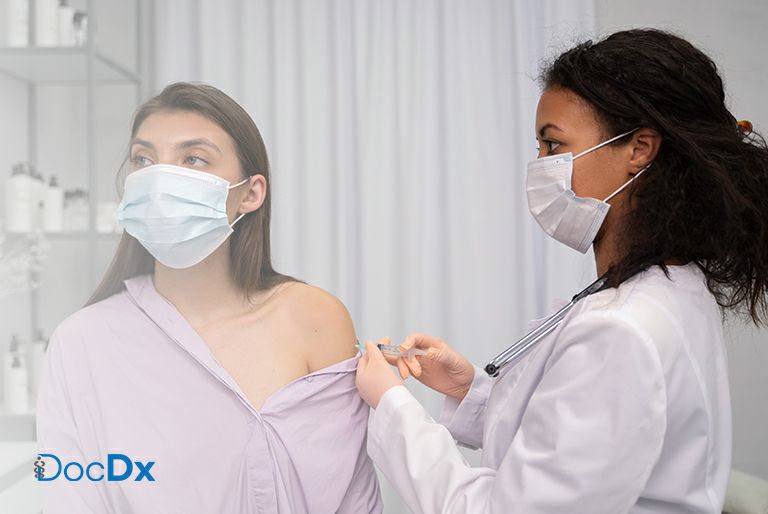Your first mammogram can feel intimidating. You may have questions like: Will it hurt? How long will it take? What if something abnormal shows up? These are completely natural concerns. The truth is, a mammogram is a simple, quick screening test that plays a powerful role in protecting women’s health. At DocDx, we understand that preventive care is about more than just tests, it’s about making you feel informed, supported, and confident in taking charge of your health.
Why Mammograms Matter
Mammograms are X-ray images of the breast used to detect early signs of breast cancer, sometimes years before symptoms appear. Early detection often means more treatment options and better outcomes. This makes regular screenings one of the most important steps in women’s preventive health.
When to Schedule Your First Mammogram
Most guidelines recommend starting routine mammograms between ages 40 and 45, but your doctor may suggest earlier screenings if you have risk factors such as:
- A family history of breast cancer
- Genetic mutations like BRCA1 or BRCA2
- Previous chest radiation therapy
If you’re unsure, your primary care provider can help you determine the right age to begin.
Preparing for Your Appointment
A little preparation can make the experience smoother. Here’s what you should know:
- Clothing: Wear a two-piece outfit so you only need to remove your top.
- Products: Avoid deodorants, powders, or lotions under your arms or on your chest—they can interfere with the X-ray.
- Timing: If possible, schedule your mammogram a week after your menstrual period, when breasts are less tender.
What Happens During a Mammogram
A mammogram is quick—typically about 20 minutes from start to finish. Here’s what to expect:
- Check-in: You’ll be asked about your medical and family history.
- Changing: You’ll change into a gown and remove clothing from the waist up.
- Positioning: A technologist will place each breast on the X-ray plate, gently compressing it for a few seconds.
- Imaging: Several images are taken from different angles.
- Completion: You’ll be able to resume your day immediately after.
Does a Mammogram Hurt?
Discomfort varies. Some women describe it as pressure, while others feel mild pain during compression. The good news? The discomfort lasts only a few seconds per image. Communicating with your technologist can help—they may adjust positioning to make it easier.
After the Screening
You may notice slight soreness or skin redness, but this typically fades within hours. Results are usually available within a week. If something unusual appears, it doesn’t always mean cancer—additional tests like ultrasounds or MRIs may be ordered for clarity.
Understanding Your Results
Mammogram results are categorized by the BI-RADS system (Breast Imaging Reporting and Data System):
- Category 1–2: Normal or benign findings
- Category 3: Probably benign, but follow-up recommended
- Category 4–5: Suspicious, requiring further evaluation
Your primary care provider will explain the results and guide next steps.
Common Myths About Mammograms
- “Mammograms cause cancer.” The radiation exposure is very low and considered safe.
- “If I feel fine, I don’t need one.” Many breast cancers are found before symptoms appear.
- “A mammogram always finds cancer.” While highly effective, no test is perfect. This is why regular screenings matter.
How Primary Care Supports Women’s Screenings
At DocDx, we emphasize preventive health. Your provider can:
- Review your medical history and personal risk factors
- Schedule routine screenings as part of annual checkups
- Provide guidance on complementary screenings like Pap smears or pelvic exams.
Caring for Your Emotional Well-being
It’s normal to feel anxious before your first mammogram. Remember:
- Bring a friend or family member for support.
- Ask questions before, during, and after the test.
- Focus on the peace of mind that comes with knowing you’re taking proactive steps for your health.
Special Considerations
- For younger women: If you have dense breast tissue, additional imaging may be recommended.
- For women with pre-existing conditions: Your provider may adjust your screening plan, much like how annual exams differ for patients with chronic conditions.
Conclusion
Your first mammogram is an important milestone in preventive health. While it may feel intimidating, knowing what to expect helps ease concerns. At DocDx, our goal is to support women through every step of the screening process with compassion, education, and personalized care. Taking charge of your health today can lead towomen a healthier tomorrow.




